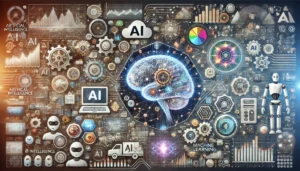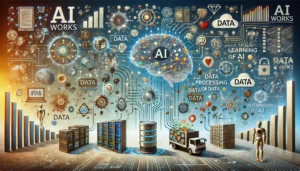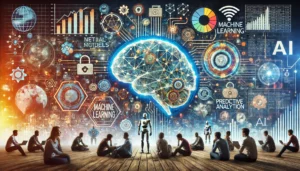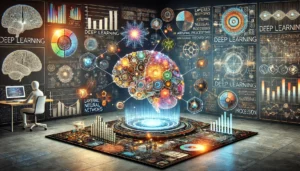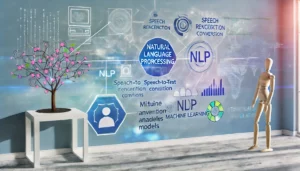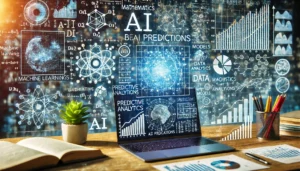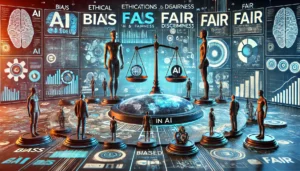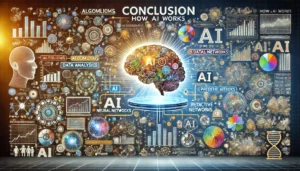Understanding the Magic Behind AI: How Machines Learn and Predict

How does AI work? Artificial Intelligence (AI) is a fascinating and rapidly evolving field that has captured the imagination of many.
But; “how does AI work?”
At its core, AI is about processing data and identifying patterns to make predictions or decisions.
Whether it’s recognising faces in photos, predicting stock market trends, or understanding human language, AI’s capabilities are vast and varied.
This article delves into the intricacies of AI, exploring how machines learn and predict, and the underlying magic that makes it all possible.
Key Takeaways that will help you understand how AI works
- AI works by processing vast amounts of data to identify patterns and make predictions or decisions.
- Machine learning, a subset of AI, involves training algorithms on data to enable them to learn and improve over time.
- Deep learning, inspired by the human brain, uses neural networks to tackle complex problems and achieve high accuracy.
- Natural Language Processing (NLP) allows machines to understand and interact with human language, opening up numerous real-world applications.
- The effectiveness of AI models relies heavily on the quality of data, mathematical foundations, and ethical considerations.
The Fundamentals of Artificial Intelligence
Defining AI and Its Scope
Artificial Intelligence (AI) refers to the simulation of human intelligence in machines that are programmed to think and learn. AI encompasses a broad range of technologies and applications, from simple calculators to complex systems that can interpret natural language and make autonomous decisions. The scope of AI is vast, covering various fields such as medicine, education, and defence, where it can significantly enhance efficiency and outcomes.
Historical Evolution of AI
In the early stages, AI was primarily theoretical, with visionaries speculating on the possibilities and potential ramifications of creating machines that could mimic human thought processes. The concept of AI was ripe with potential, opening the doors to endless possibilities and applications. Over the decades, AI has evolved from basic rule-based systems to advanced machine learning models that can learn and adapt over time. This evolution has been driven by advancements in computing power, data availability, and algorithmic innovations.
Key Components of AI Systems
AI systems are built on several key components that work together to enable intelligent behaviour. These include:
- Data: The foundational element that AI systems learn from. The quality and quantity of data directly impact the performance of AI models.
- Algorithms: The mathematical formulas and rules that guide the learning process. Different algorithms are suited for different types of tasks, such as classification, regression, or clustering.
- Computing Power: The hardware and software infrastructure that supports the processing and analysis of large datasets. Advances in GPU technology have significantly accelerated AI research and applications.
- Human Expertise: The domain knowledge and expertise required to design, implement, and interpret AI systems. Human oversight is crucial to ensure that AI systems are aligned with ethical standards and societal values.
Understanding the fundamentals of AI is essential for anyone looking to navigate the rapidly evolving landscape of technology. By grasping the basics, you can better appreciate the complexities and potential of AI systems.
How does AI work? Data: The Lifeblood of AI
Types of Data Used in AI
AI systems rely on a variety of data types to function effectively. These include structured data, such as databases and spreadsheets, and unstructured data, like text, images, and videos. Structured data is highly organised and easily searchable, while unstructured data requires more sophisticated processing techniques to extract meaningful insights. Additionally, semi-structured data, which includes elements of both, plays a crucial role in many AI applications.
Data Collection and Preparation
The process of collecting and preparing data is fundamental to the success of any AI project. This involves gathering relevant data from various sources, cleaning it to remove any inconsistencies or errors, and transforming it into a format suitable for analysis. Data preprocessing is a critical step that ensures the quality and reliability of the data, ultimately impacting the performance of the AI model.
The Role of Big Data in AI
Big Data has revolutionised the field of AI by providing the vast amounts of information needed to train complex models. The sheer volume, variety, and velocity of Big Data enable AI systems to uncover patterns and make predictions with unprecedented accuracy. However, managing and processing such large datasets presents significant challenges, requiring advanced storage solutions and powerful computational resources.
The synergy between Big Data and AI is undeniable. As data continues to grow exponentially, the potential for AI to drive innovation and solve complex problems becomes even greater.
Machine Learning: The Heart of AI
Supervised vs. Unsupervised Learning
Machine Learning (ML) is a subset of AI that focuses on developing algorithms allowing machines to learn from data. Instead of being explicitly programmed, machines use statistical techniques to improve their performance on a specific task over time. At the heart of machine learning is the idea that a system can learn from data. Instead of hand-coding specific instructions for every task, you feed an algorithm data, and it learns patterns or structures from this data.
Common Machine Learning Algorithms
There are several types of machine learning algorithms, each suited for different tasks. Some of the most common include:
- Linear Regression: Used for predicting a continuous variable.
- Decision Trees: Useful for classification tasks.
- K-Nearest Neighbors (KNN): A simple, instance-based learning algorithm.
- Support Vector Machines (SVM): Effective for high-dimensional spaces.
- Neural Networks: The foundation of deep learning.
Training and Testing Models
Training a machine learning model involves feeding it a large amount of data and allowing it to learn the patterns within that data. This is known as the training phase. Once the model has been trained, it is then tested on a separate set of data to evaluate its performance. This helps ensure that the model can generalise well to new, unseen data.
The process of training and testing is crucial for developing robust machine learning models. It ensures that the model not only performs well on the training data but also on new, unseen data.
In summary, machine learning is the engine that drives AI, enabling machines to learn from data and make predictions or decisions based on that learning. Whether it’s supervised or unsupervised learning, the goal is to create models that can generalise well and provide accurate results.
Deep Learning: Mimicking the Human Brain
Neural Networks Explained
Deep learning is like the “engine” powering many advanced AI applications. Inspired by the structure and function of the human brain, it uses complex algorithms and vast amounts of data to learn incredibly complex patterns. Imagine a network of interconnected neurons, but built using code, allowing machines to process information. Deep learning leverages powerful artificial neural networks with multiple layers, mimicking the structure and function of the human brain. These complex architectures excel at tasks that were once considered too challenging for machines, such as image and speech recognition.
Applications of Deep Learning
Deep learning is a major driver of advancements in facial recognition software, natural language processing for chatbots and virtual assistants, and even the development of self-driving cars. Like neural networks, deep learning is modelled on the way the human brain works and powers many machine learning uses, like autonomous vehicles, chatbots, and medical diagnostics.
Challenges in Deep Learning (How does AI work?)
Deep learning requires a great deal of computing power, which raises concerns about its economic and environmental sustainability. The layered network can process extensive amounts of data and determine the “weight” of each link in the network — for example, in an image recognition system, some layers of the neural network might detect individual features of a face, like eyes, nose, or mouth, while another layer would be able to tell whether those features appear in a way that indicates a face.
The more layers you have, the more potential you have for doing complex things well.
Natural Language Processing: Teaching Machines to Understand Us
How NLP Works
Natural language processing (NLP) is a field of machine learning where machines learn to understand natural language as spoken and written by humans. This allows machines to recognise language, understand it, and respond to it, as well as create new text and translate between languages. NLP enables familiar technology like chatbots and digital assistants such as Siri or Alexa. It’s like teaching a computer to speak and understand our human language, opening up a new world of possibilities.
Real-World Applications of NLP
NLP powers the chatbots that engage in conversations with us, language translation tools that break down linguistic barriers, and even systems that analyse text, speech, and emotions. For instance, a London PPC agency might use NLP to analyse customer feedback and optimise ad campaigns based on sentiment analysis. Here are some common applications:
- Customer Support: Automating responses to common queries.
- Voice Commands: Understanding and executing spoken instructions.
- Document Processing: Extracting and categorising information from unstructured text.
Future Trends in NLP
The future of NLP is promising, with advancements aimed at making machines even better at understanding context and nuances in human language. Expect improvements in areas like real-time translation, emotion detection, and more sophisticated conversational agents. The integration of NLP with other AI technologies will further enhance its capabilities, making it an indispensable tool for businesses and individuals alike.
As NLP technology evolves, it will become increasingly adept at understanding the subtleties of human language, making interactions with machines more seamless and intuitive.
The Mathematics Behind AI Predictions
Statistical Foundations
At the heart of AI predictions lies a robust foundation in statistics. By analysing vast datasets, AI models identify patterns and correlations that might be invisible to the human eye. Statistical methods such as regression analysis, hypothesis testing, and probability distributions are crucial. These methods allow AI to make informed predictions, whether it’s for eCommerce PPC campaigns or healthcare diagnostics.
Optimisation Techniques
Optimisation is the process of making a system as effective or functional as possible. In AI, optimisation techniques are used to fine-tune models to achieve the best performance. Techniques like gradient descent, linear programming, and genetic algorithms help in minimising errors and improving accuracy. For instance, in Google Adwords PPC campaigns, optimisation ensures that ads reach the right audience at the right time, maximising ROI.
Evaluating Model Performance
Evaluating the performance of AI models is essential to ensure their reliability and effectiveness. Metrics such as accuracy, precision, recall, and F1 score are commonly used. These metrics help in understanding how well a model is performing and where it might need improvements. For example, in Google ads PPC strategies, evaluating model performance can help in adjusting bids and targeting to improve campaign outcomes.
Understanding the math behind AI predictions empowers us to harness the potential of this transformative technology. It enables businesses to make data-driven decisions, improves healthcare outcomes, optimises manufacturing processes, and much more.
Ethical Considerations in AI
Bias and Fairness in AI
The growth and capabilities of AI naturally bring forth ethical quandaries. One of the most pressing issues is bias and fairness. AI models learn from data, and if that data carries biases, so will the AI. Ensuring fairness and mitigating biases in AI models will remain a top concern. Instances of bias and discrimination across a number of machine learning systems have raised many ethical questions regarding the use of artificial intelligence. How can we safeguard against bias and discrimination when the training data itself may be generated by biased human processes?
Privacy Concerns (How does Artificial Intelligence work?)
As AI integrates deeper into our lives, how it handles and respects personal data will be crucial. We’ve already seen issues with certain AI-powered devices eavesdropping on users. This will need stringent checks. The decisions made by AI systems are life-altering, ranging from hiring processes that employ algorithms for decision-making to criminal justice decisions influenced by predictive analysis. With great power comes great responsibility, and AI is no exception.
The Future of Ethical AI
The future of ethical AI will involve continuous monitoring and updating of AI systems to ensure they adhere to ethical standards. Companies will need to conduct regular PPC audits and Google ads audits to ensure their AI-driven advertising strategies are fair and unbiased. The role of PPC management and PPC ad agencies will be crucial in maintaining ethical standards. As our AI journey unfolds, we meet the ethical dilemma associated with this technological wonder. While companies typically have good intentions for their automation efforts, unforeseen consequences can arise, making it essential to have robust ethical guidelines in place.
Ethical considerations in AI are not just about preventing harm but also about promoting fairness, transparency, and accountability in all AI-driven processes.
Conclusion on “How does AI work?”
Artificial Intelligence (AI) is not just a buzzword; it is a transformative technology that leverages the power of data and mathematics to make accurate predictions and decisions. By analysing vast amounts of information, AI identifies patterns and relationships that are often invisible to the human eye. This capability allows AI to continuously learn and improve, making it an invaluable tool in various fields, from finance to healthcare. Understanding the magic behind AI involves appreciating the intricate dance of algorithms and data, which together unlock the full potential of this remarkable technology. As we continue to advance in this field, the possibilities for AI are boundless, promising a future where machines not only assist but also enhance our decision-making processes.
Machine learning models can make highly accurate predictions, but without proper oversight, they may introduce risks or biases. Governance across the AI lifecycle ensures AI systems remain transparent, ethical, and compliant—key factors for businesses integrating AI at scale.
Frequently Asked Questions for How Does AI Work?
How does AI work?
AI works by processing data and identifying patterns. This data can be in the form of text, images, or even sounds. Once the AI has identified a pattern, it can use that information to make predictions or decisions. For instance, an AI trained on countless financial news articles might be able to predict future stock market trends.
What is the role of data in AI?
Data is the lifeblood of AI. By analysing vast amounts of data, AI systems can uncover hidden patterns and correlations which enable them to make accurate predictions and decisions.
What is machine learning?
Machine learning is a subset of AI that focuses on training machines to learn from data. It involves using algorithms and statistical models to enable computers to improve their performance on a task over time without being explicitly programmed.
How do neural networks work in AI?
Neural networks are a series of algorithms that mimic the human brain’s structure and function. They are used in deep learning to recognise patterns and make decisions based on data inputs. Each ‘neuron’ in the network processes input data and passes it to the next layer, gradually refining the output.
What are the ethical concerns surrounding AI?
Ethical concerns in AI include issues of bias and fairness, privacy, and the potential for AI to be used in harmful ways. Ensuring that AI systems are designed and used ethically is crucial for their responsible deployment.
What is natural language processing (NLP)?
Natural Language Processing (NLP) is a branch of AI that focuses on enabling machines to understand, interpret, and respond to human language. It is used in applications such as chatbots, language translation, and sentiment analysis.
Author
Search Blog
Free PPC Audit
Subscribe to our Newsletter
The Voices of Our Success: Your Words, Our Pride
Don't just take our word for it. With over 100+ five-star reviews, we let our work-and our satisfied clients-speak for us.
"We have been working with PPC Geeks for around 6 months and have found Mark and the team to be very impressive. Having worked with a few companies in this and similar sectors, I rate PPC Geeks as the strongest I have come across. They have taken time to understand our business, our market and competitors and supported us to devise a strategy to generate business. I value the expertise Mark and his team provide and trust them to make the best recommendations for the long-term."
~ Just Go, Alasdair Anderson

